Proliferative vitreoretinopathy (PVR) can be thought of as a reparative or scarring mechanism. Contact inhibition is lost because of mechanical disruption of a tissue such as the retinal pigment epithelium (RPE), and the response is migration, contraction, and moderate proliferation of cells. A defect in the internal limiting membrane (ILM) can be created by vitreous traction, a retinal break, or membrane dissection. Glial cells then migrate, proliferate to some extent, and contract the retinal surface as if to repair the retina-ILM defect. Retinal breaks “heal” as a result of this mechanism as has been shown in macular hole surgery and retinotomies for submacular surgery. Similarly, if the retina is separated from the RPE, the RPE cells migrate to the retinal surface and the posterior surface of the posterior vitreous cortex (PVC). Monocytes can gain access to the retinal surface from the iris and ciliary body capillaries as a result of ocular inflammation. It is known that these cells can migrate, proliferate, and contract on the retinal surface (1–13). Glial, RPE, and monocytic cells share in common the migration along an existing substrate or to a new tissue surface. As cellular migration occurs, intracellular contraction of the cells occurs, creating tangential traction on the retina. All healing mechanisms studied have demonstrated a microtubule, smooth muscle-like contraction process occurring with many cells acting in concert. The myofibroblasts have coated pits, which have specific receptor sites for collagen, fibrin, and elastin. These pits contain fibronectin, which allows the cells to attach to collagen fibers (14,15). Growth factors (TGF-β, etc.), metalloproteinases, fibronectin, and receptors for collagen, elastin, and fibrin are components of the migration and contraction phenomenon. Proliferation (mitotic activity) is of much lesser importance. This process can be thought of as hypocellular periretinal scarring, analogous to hypocellular vitreous contraction. PVR is somewhat of a misnomer; there is minimal mitotic activity in PVR, and antimetabolites have been shown to be ineffective; in fact, the disease is more like a keloid. To emphasize the hypocellular nature of this process, the authors suggest taking the “P” out of PVR. Like a keloid, PVR is excessive healing or scarring. Scarring is biologically identical to healing; scarring is basically a functional description. PVR should be thought of as a hypocellular interaction between various cell types and the extracellular matrix (ECM). RPE cells, glial cells, and inflammatory cells have been shown to be involved in PVR. Better understanding of the disease process leads to better treatment strategies; excessive retinopexy leads to PVR, and repeated surgical interventions with brief intervals between procedures are common causes of PVR. Lengthy procedures, extensive retinopexy, iris trauma (retractors), combined phaco and intraocular lens (IOL) implantation, and excessive peripheral “membrane peeling” instead of retinectomy are all factors in iatrogenic PVR. Unlike cancer surgery or draining an abscess, the goal is minimal tissue destruction, not removal of all pathologic tissue. The PVR surgeon should think like a plastic surgeon, not a cancer surgeon.
Tangential shortening of the cells occurs prior to collagen production, which may be thought of as a late stabilization phase. The generation of basement membrane and collagen can be thought of as a recreation of Bruch’s membrane or the ILM, as if to duplicate the process that occurs in embryonic development.
PVR can be localized and create isolated star folds, fixed folds, subretinal changes, or epimacular membranes (16– 18). It can be more widespread, which gave rise to the no longer used term, “massive periretinal proliferation.” If the proliferation of glial or RPE cells extended onto the contiguous posterior surface of the PVC, the older term “massive vitreous retraction” would have been used. At this time, there is no proof of the role of hyalocytes in the pathogenesis.
Understanding surgical anatomy is a crucial component of surgical intervention. Core vitrectomy is actually removal of confluent PVC and anterior vitreous cortex (AVC) in the frontal plane (FP); there is no spherical core vitreous in these cases. It is important to recall that the vitreous base has no volume and cannot be “shaved” as surgeons often state; it is a zone of adherence between the peripheral vitreous and the retina. Often surgeons state that they perform vitreous base dissection; this is simply not the case, although so-called shaving of the peripheral vitreous close to the retina surface is essential. Circumferential vitreous collagen fibers shortened by hypocellular contraction pull the equator inward; these fibers are contiguous with the vitreous base and rarely removable by peeling. Anterior-posterior–oriented vitreous collagen formerly contiguous with the vitreous base shortened by hypocellular contraction causes what the principal author initially identified as anterior loop traction; resection of this component of anterior PVR is essential to reduce the anterior pull on equatorial retina. Epiretinal membranes (ERMs) are always behind to the posterior margin of the vitreous base; peeling peripheral PVR membranes is a misnomer as well.
Scarring in the subretinal space can occur in many physical configurations, as discussed later (see “Subretinal Proliferation”). A placoid configuration can create an inverted star fold configuration. Subretinal bands (strands) occur presumably as tubes of RPE cells proliferate along a fibrin strand; these then contract, causing an extended dendritic configuration. If the band is circumferential at the midretinal level, it can create an annular configuration with a resultant closed cone retinal detachment.
CASE SELECTION
Vitrectomy Versus Scleral Buckling
Vitrectomy should be thought of as a mechanical approach to a mechanical problem caused by retinal traction. It has no known prophylactic benefit in the prevention of PVR nor is it an approach to be utilized only after several scleral buckles are tried. The authors utilize 25-gauge vitrectomy techniques without scleral buckling for practically all cases of retinal detachment secondary to PVR.
Operability
Extensive star folds, even in a closed cone (funnel) configuration, are usually operable. If extensive membrane peeling has been performed, the recurrent proliferation may be more adherent to the retinal surface. Excessive retinopexy probably causes RPE and glial reproliferation, while retinal surface dissection probably causes glial proliferation. If extensive subretinal placoid proliferation is present, this is often inoperable. Redundant retina can simulate diffuse subretinal placoid proliferation, making clinical assessment difficult. The presence of large retinal breaks and extensive surface proliferation was thought of as inoperable before the advent of epiretinal and subretinal dissection, internal drainage of subretinal fluid (SRF), retinectomy, and silicone oil. In addition to the mechanically inoperable configurations, there are many patient-based and biologic decisions related to operability. If the patient has an apparently operable mechanical configuration but has had many recurrences after vitrectomy, surgery might be contraindicated because of biologic behavior, especially if the patient has another functional eye, has medical problems, or is very elderly. Iris neovascularization, glaucomatous cupping, and severe uveitis can influence the decision of operability as well.
Cases with extremely recent proliferative activity and an inflammatory component have a worse prognosis than inactive cases (19). In such cases, a period of observation and subconjunctival steroids should precede surgery (19; R.G. Michels, personal communication). A definite life cycle as described by S. J. Ryan characterizes this reparative or scarring process. Recurrent proliferation is reduced if reoperation is delayed until the proliferation stabilizes and inflammation is minimal. Proliferative inactivity can be judged by the presence of minimal cells and flare, waning conjunctival hyperemia, comfort, and lack of further progression of ERMs.
SURGICAL SEQUENCE AND TECHNIQUES
Management of the Lens or Intraocular Lens
The crystalline lens may be retained in most cases of posterior PVR but may require removal in the presence of anterior PVR to allow adequate dissection of the anterior vitreous and prevent cyclitic membrane formation. Endocapsular lensectomy should be utilized if the eye is extremely inflamed; otherwise, phaco-vit should be used to facilitate posterior containment of silicone oil.
If a posterior chamber IOL is present, it should be retained. Selected anterior chamber and iris plane lenses must be removed. Implant removal can occasionally result in an intraoperative hemorrhage or corneal and iris damage and compromise the surgical result. Corneal incisions, viscoelastics, and haptic cutting minimize the incidence of intraoperative hemorrhage. Cut haptics can be left if bleeding is anticipated because of fibrous scarring around the haptic. The hypotony that occurs during lens removal can theoretically cause choroidal hemorrhage.
COMPARTMENTALIZATION
Serum components and inflammation play a role in the causation and acceleration of PVR. A source tissue produces growth factors, which then target substrate tissues. The target tissue (retina) is in the same compartment as the source in PVR, but on remote surfaces in proliferative diabetic retinopathy (vascular endothelial growth factor [VEGF], iris and trabecular meshwork). Viscoelastics, fibrin, inflammation, and blood can be thought of as culture media enhancing PVR. The lens or IOL creates a two-compartment eye, prolonging the cell culture–like environment and providing a migration substrate. Removal of the lens in PVR cases increases the egress rate of cytokines, cells, and serum components such as fibronectin through the trabecular meshwork. Similarly, gases and silicone produce sequestration of cells and factors at the retinal-bubble interface, enhancing PVR.
VITRECTOMY
The AVC is removed first, along with all vitreous attachments to cataract and trauma wounds, and the iris. Very low suction force using the proportional suction control should be utilized to prevent retinal breaks from suction-induced vitreoretinal traction. The highest cutting rates should be used to increase fluidic stability. The PVC is frequently in contact with the AVC and removable in a single step. A posterior vitreous detachment is almost always present in PVR cases. Hypocellular vitreous contraction causes the PVC and AVC to come together in a “frontal plane” configuration (Fig. 16.1). “Core vitrectomy” is a misnomer; a core configuration does not exist in PVR eyes.
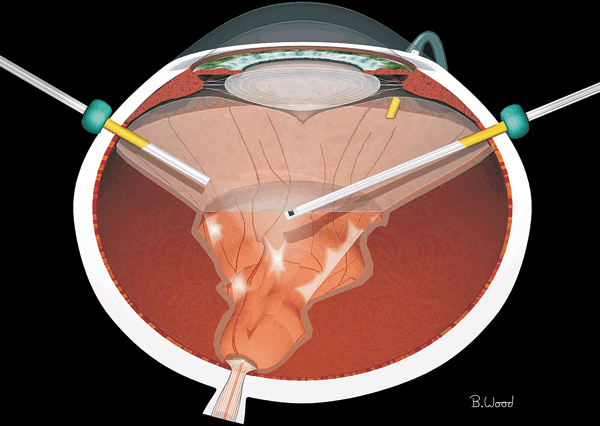
Figure 16.1  The AVC and PVC undergo hypocellular contraction of the collagen fibers resulting in confluence and an FP sheet. The FP component should be removed before forceps membrane peeling of star folds.
The AVC and PVC undergo hypocellular contraction of the collagen fibers resulting in confluence and an FP sheet. The FP component should be removed before forceps membrane peeling of star folds.
Anterior Proliferative Vitreoretinopathy
Anteroposterior vitreous fibers normally extend from the retina at the posterior edge of the vitreous base to the pars plana, ciliary body, and iris. Frequently, these fibers undergo hypocellular vitreous contraction and pull the equatorial retina anteriorly into a circumferential fold. The author (S.C.) first described this phenomenon as anterior loop contraction in 1975. A circumferential equatorial ring of ERM or contracted equatorial vitreous is typically present in PVR. Hypocellular contraction of the AVC and PVC is also common in PVR cases. Collectively, these structures are known as anterior PVR. They are frequently incorrectly termed “vitreous membranes” or the “vitreous base.” Anterior PVR must be relieved to allow retinal reattachment.
Scleral depression by the assistant facilitates anterior PVR dissection. The radial component of anterior PVR dissection can be done with the vitreous cutter, if broad, or delamination scissors, if narrow (Fig. 16.2). The 25-gauge ILM forceps can be used to peel posterior ERMs in an anterior direction to the posterior edge of the vitreous base. Blunt dissection with the vitreous cutter and endoilluminator can be used to separate vitreous and ERM from peripheral retina. Delamination scissors can be used to delaminate or segment the circumferential component (Fig. 16.3).
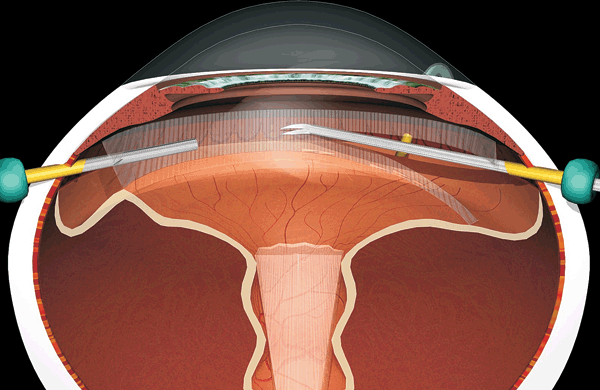
Figure 16.2  The radial (anteroposterior) component of anterior PVR is also called anterior loop traction. It can be resected with curved scissors if it is not broad enough to permit transaction with the vitreous cutter. The 25-gauge cutter is preferred because the compact tip facilitates access.
The radial (anteroposterior) component of anterior PVR is also called anterior loop traction. It can be resected with curved scissors if it is not broad enough to permit transaction with the vitreous cutter. The 25-gauge cutter is preferred because the compact tip facilitates access.
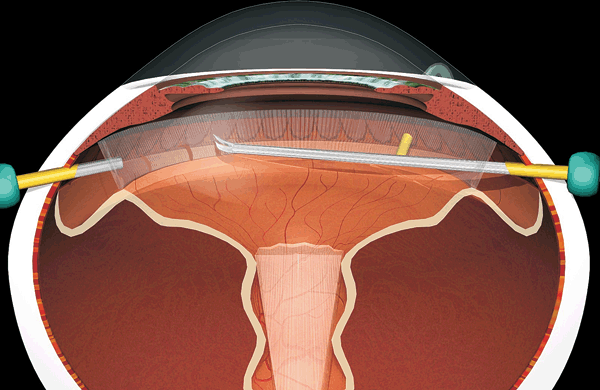
Figure 16.3  Curved scissors can be used to segment or delaminate ERM and condensed circumferential fibers on the equatorial surface of the retina.
Curved scissors can be used to segment or delaminate ERM and condensed circumferential fibers on the equatorial surface of the retina.
Epiretinal Membranes
Membrane peeling can cause retinal breaks and hemorrhage implicated in the recurrence of cellular migration, contraction, and proliferation. Often, the ERMs peel easily with none of these problems and allow complete release of tangential traction (Fig. 16.4). End-grasping forceps membrane peeling is preferable to using pics or forceps with one blade under the ERM because the end-grasping forceps contact the ERM, not the retina. Use of forceps without pics reduces the incidence of iatrogenic retinal breaks. The principal author refers to this approach as inside-out forceps membrane peeling; it is the same direction of dissection used for epimacular membranes, ILM, as well as scissors segmentation and delamination. The senior author initially developed diamond-coated, 20-gauge forceps for membrane peeling, then developed conformal forceps, and more recently transitioned to Alcon 25-gauge DSP ILM forceps with conformal tips. The senior author has not used pics since 1978. Alcon 25-gauge DSP ILM forceps are ideal for this technique. The endgrasping forceps should be applied to the apparent epicenter of a star fold, or the outer margin only if clearly visible. It is usually best to use the forceps to peel toward the periphery because central retina is much stronger than peripheral retina. Peripheral ERMs may extend to the vitreous base; once lifted from the retina surface, they can be removed with the vitreous cutter often while removing anterior loop traction. If the membranes are tightly adherent, they should be segmented and/or delaminated with 25-gauge curved scissors. Retinectomy may be required if forceps membrane peeling, segmentation, or delamination of the ERM causing a star fold, fixed fold, or zone of retinal-retinal adherence cannot be completed. A specific attempt must be made to release the ERM causing circumferential traction at the equator by using scissors segmentation or delamination. If this cannot be safely accomplished because of tight adherence to the retinal surface, this portion of ERM can be left intact and supported by the very broad and high buckle or retinectomy performed. Frequently, dense ERM can be delaminated from the retinal surface with curved delamination scissors with the blades parallel to the retinal surface. Segmentation of the denser portions of an ERM using the curved scissors is very effective in releasing traction and tends to be underutilized (Fig. 16.5). When the entire surface of the retina can be visualized and the sharp angulations have been converted to rounded contours, dissection is complete.
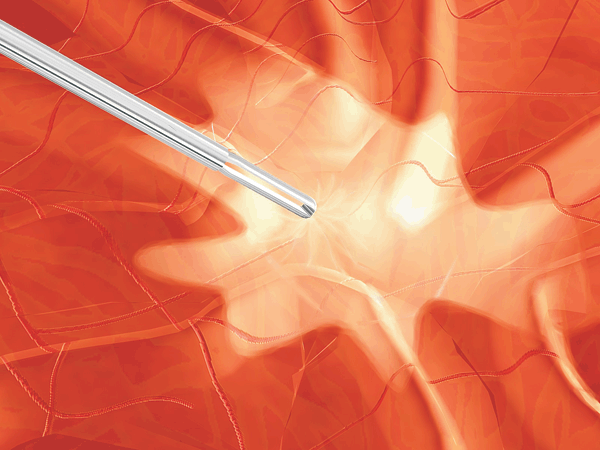
Figure 16.4  Inside-out forceps membrane peeling with Alcon 25-gauge DSP ILM forceps is used to remove ERMs. Pics, viscodissection, and forceps with one blade under the ERM are more likely to damage the retinal surface.
Inside-out forceps membrane peeling with Alcon 25-gauge DSP ILM forceps is used to remove ERMs. Pics, viscodissection, and forceps with one blade under the ERM are more likely to damage the retinal surface.

Figure 16.5  Inside-out segmentation of dense ERM with curved scissors is very effective and tends to be underutilized.
Inside-out segmentation of dense ERM with curved scissors is very effective and tends to be underutilized.
Subretinal Proliferation
Many anatomic forms of subretinal proliferation occur, just as there is variability in the configuration of ERMs. The term “strands” is a misnomer because of the frequent occurrence of placoid elements.
Placoid subretinal proliferation, if moderate in extent, is managed by attempting internal drainage of SRF, fluid-air exchange, and completion of SRF drainage. If the retina becomes attached, subretinal surgery, and/or scleral buckling are not required. If there is extensive proliferation, subretinal forceps removal is required.
Dendritic proliferation can usually be managed by forceps removal (Fig. 16.6) or segmentation, followed by internal drainage of SRF, fluid-air exchange, and completion of SRF drainage. The diamond-coated, end-opening forceps, or 25-gauge DSP forceps are pushed through the retina over the densest part of the subretinal proliferation (Fig. 16.7) and used to grasp and remove the tissue (Fig. 16.8). Care must be taken to avoid entrapping the retina in the forceps or damaging the RPE or choroid. Frequently, the dendrite will break, releasing the traction.
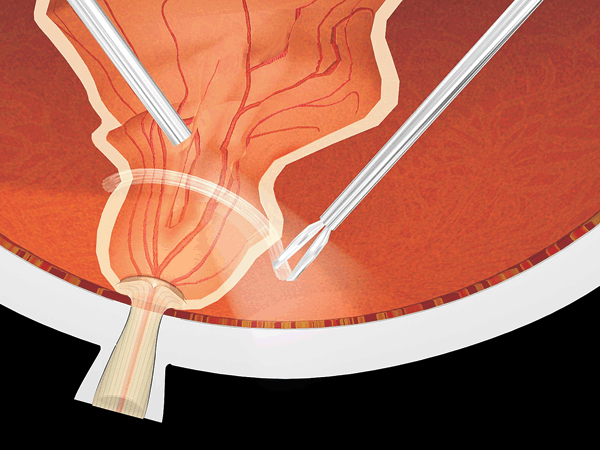
Figure 16.6  Dendritic subretinal proliferation can be removed with forceps through a preexisting retinal defect.
Dendritic subretinal proliferation can be removed with forceps through a preexisting retinal defect.
Stay updated, free articles. Join our Telegram channel

Full access? Get Clinical Tree


